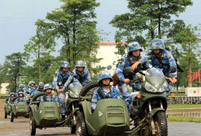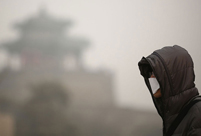 'Jin' named the word of the year by cross-strait netizens
'Jin' named the word of the year by cross-strait netizens Chinese scientific expedition goes to build new Antarctica station
Chinese scientific expedition goes to build new Antarctica station
 Chinese naval escort fleet conducts replenishment in Indian Ocean
Chinese naval escort fleet conducts replenishment in Indian Ocean 17th joint patrol of Mekong River to start
17th joint patrol of Mekong River to start China's moon rover, lander photograph each other
China's moon rover, lander photograph each other Teaming up against polluters
Teaming up against polluters
Rome, December 30 - A quick succession of three earthquakes shook mountains in the Campania region around Naples early Monday, scaring residents out of bed and into the streets following a stronger quake in the same area a day earlier.
Only light damage was reported in the Matese area, a mountain ridge that stretches into the rural Molise region as well. Among the damage was a 16th-century church in the town of Piedimonte Matese which suffered deep cracks in the nave and walls. "I was celebrating Mass and the church was packed when I heard a huge roar and feared the ceiling was going to cave in," said the church priest. Firefighters had also closed off the Reggia di Caserta, the largest palace built in Europe in the 18th century, while inspections were underway in areas that had already been at serious risk since last year. Monday's tremors spanned from 3.1-3.2 magnitude, following a 4.9-magnitude quake a day earlier. Seismologists were examining the area in the event of further threats.
Interior Minister and Deputy Premier Angelino Alfano called an emergency meeting with the Civil Protection Agency and firefighters to assess the damage and review their response. "First-responders and the Civil Protection Agency did their jobs. Their collaboration was excellent," said Alfano at the meeting. The interior ministry said over 100 tremors below 3-point magnitude shook the area over the same course of time.
The spectre of recent, devastating earthquakes in the northern Emilia-Romagna region in 2012 and the central city of L'Aquila in 2009, has primed Italians not to underestimate the possible warning posed by even relatively small earthquakes.
Tremors preceded a 5.8-magnitude earthquake in L'Aquila, on April 6, 2009, that killed over 300 people and left about 65,000 more homeless.
Prior to the quake, quivering ground had spooked people from their homes and prompted the Italian National Commission for the Forecast and Prevention of Major Risks to meet over the danger of a major earthquake one week before it hit.
In a controversial trial, a L'Aquila court ruled in October 2012 that the commission's report downplayed the likelihood of a major quake, lulling residents into returning to or remaining in unsafe structures.
The court sentenced six scientists and an ex-government official to six years in prison for multiple manslaughter.
In May 2012, two major earthquakes shook Emilia-Romagna.
The first earthquake, on May 20, registered magnitude 5.9, and was followed about eleven hours later by two aftershocks, both of magnitude 5.2.
Seven people died in the first event, but when a 5.8-magnitude quake struck the same area nine days later, it killed another 20 people and wrought widespread damage, especially to structures already weakened by the earlier event.
Despite reassurances from the government, further concerns over earthquake risks were raised in October when Civil Protection chief Franco Gabrielli said "Italy is going to pieces" due to hydrogeological instability.
Speaking at the Water Festival in L'Aquila, Gabrielli warned that Italy "cannot let down its guard".
"For me to return to L'Aquila is a (source of) satisfaction on the one hand but also pain on the other until this city returns, I won't say to its former glory, but at least to the sparkle it deserves. For me it is still an open wound. "We are facing a major economic crisis, but the subject of resources must worry us because we must never let down our guard".
 Commemorate 120th birth anniversary of Mao Zedong
Commemorate 120th birth anniversary of Mao Zedong Female soldiers of PLA Marine Corps in training
Female soldiers of PLA Marine Corps in training Chinese cities to have a very grey Christmas as smog persists
Chinese cities to have a very grey Christmas as smog persists China and U.S. - the national image in each other’s eyes
China and U.S. - the national image in each other’s eyes The Liaoning's combat capability tested in sea trial
The Liaoning's combat capability tested in sea trial Chinese pole dancing team show their moves in snow
Chinese pole dancing team show their moves in snow Rime scenery in Mount Huangshan
Rime scenery in Mount Huangshan Ronnie O'Sullivan: My children mean the world to me
Ronnie O'Sullivan: My children mean the world to me Shopping in Hong Kong: a different picture
Shopping in Hong Kong: a different picture Yearender: Animals' life in 2013
Yearender: Animals' life in 2013 Hello 2014 - Chinese greet the New Year
Hello 2014 - Chinese greet the New Year Chocolate 'Terracotta Warriors' appear
Chocolate 'Terracotta Warriors' appear  Top 10 domestic news of 2013
Top 10 domestic news of 2013 Red crabs begin annual migrations in Australia
Red crabs begin annual migrations in Australia Artifacts retrieved from West Zhou Dynasty
Artifacts retrieved from West Zhou DynastyDay|Week|Month